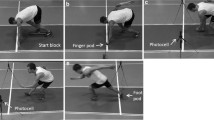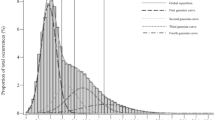Abstract
Most physiological testing of athletes is performed in well-controlled situations in the laboratory. Multiple factors that are hard to control for have limited the use of sport-specific field testing. Recently, the technique of the differential global positioning system (dGPS) has been put forward as a way to monitor the position and speed of an athlete during outdoor activities with acceptable precision, thus controlling the two most important factors of performance in endurance athletics, i.e. inclination and speed. A detailed analysis of performance has been shown to be possible in combination with metabolic gas measurements. The combination of accelerometry and dGPS has also been shown to improve physiological field testing. The technique of dGPS could probably also be combined with other bio-measurements (e.g. electromyography and cycling cadence and power) and may enable other studies of exercise physiology in the field, otherwise restricted to the laboratory environment. This technique may also be of use in general exercise physiology where monitoring of patients with, for example, cardiovascular and pulmonary diseases, could be of interest for the future.





Similar content being viewed by others
References
Noakes TD. Physiological models to understand exercise fatigue and the adaptations that predict or enhance athletic performance. Scand J Med Sci Sports 2000; 10: 123–45
Wasserman K, Hansen JE, Sue DY, et al. Principles of exercise testing and interpretation. Philadelphia (PA): Lea & Febiger, 1987
Creagh U, Reilly T, Nevill AM. Heart rate response to ‘off-road’ running events in female athletes. Br J Sports Med 1998; 32: 34–8
Bird SR, Bailey R, Lewis J. Heart rates during competitive orienteering. Br J Sports Med 1993; 27: 53–7
Peck G. Measuring heart rate as an indicator of physiological stress in relation to orienteering performance. Sci J Orienteering 1990; 12: 26–42
Åstrand PO, Saltin B. Maximal oxygen uptake and heart rate in various types of muscular activity. J Appl Physiol 1961; 16: 977–81
Doyon KH, Perrey S, Abe D, et al. Field testing of V̇O2peak in cross-country skiers with portable breath-by-breath system. Can J Appl Physiol 2001; 26: 1–11
Millet GY, Hoffman MD, Candau RB, et al. Effect of rolling resistance on poling forces and metabolic demands of roller skiing. Med Sci Sports Exerc 1998; 30: 755–62
Hoffman MD, Clifford PS. Physiological responses to different cross country skiing techniques on level terrain. Med Sci Sports Exerc 1990; 22: 841–8
Saibene F, Cortili G, Roi G, et al. The energy cost of level cross-country skiing and the effect of the friction of the ski. Eur J Appl Physiol Occup Physiol 1989; 58: 791–5
Jensen K, Franch J, Kärkkäinen OP, et al. Field measurements of oxygen uptake in elite orienteers during cross-country running using telemetri. Scand J Med Sci Sports 1994; 4: 234–8
Jensen K, Johansen L, Kärkkäinen OP. Economy in track runners and orienteers during path and terrain running. J Sports Sci 1999; 17: 945–50
Gjerset A, Johansen E, Moser T. Aerobic and anaerobic demands in short distance orienteering. Sci J Orienteering 1997; 13: 4–25
Moser T, Gjerset A, Johansen E, et al. Aerobic and anaerobic demands in orienteering. Sci J Orienteering 1995; 11: 3–30
Niinimaa V, Dyon M, Shephard RJ. Performance and efficiency of intercollegiate cross-country skiers. Med Sci Sports 1978; 10: 91–3
MacDougall JD, Hughson R, Sutton JR, et al. The energy cost of cross-country skiing among elite competitors. Med Sci Sports 1979; 11: 270–3
Karvonen J, Kubica R, Kalli S, et al. Effects of skating and diagonal techniques on skiing load and results in cross-country skiing. J Sports Med Phys Fitness 1987; 27: 473–7
Karvonen J, Kubica R, Wilk B, et al. Effects of skating and diagonal skiing techniques on results and some physiological variables. Can J Sport Sci 1989; 14: 117–21
Mognoni P, Rossi G, Gastaldelli F, et al. Heart rate profiles and energy cost of locomotion during cross-country skiing races. Eur J Appl Physiol 2001; 85: 62–7
Mahood NV, Kenefick RW, Kertzer R, et al. Physiological determinants of cross-country ski racing performance. Med Sci Sports Exerc 2001; 33: 1379–84
Terrier P, Aminian K, Schutz Y. Can accelerometry accurately predict the energy cost of uphill/downhill walking? Ergonomics 2001; 44: 48–62
Montoye HJ, Washburn R, Servais S, et al. Estimation of energy expenditure by a portable accelerometer. Med Sci Sports Exerc 1983; 15: 403–7
Melanson Jr EL, Freedson PS. Validity of the Computer Science and Applications, Inc. (CSA) activity monitor. Med Sci Sports Exerc 1995; 27: 934–40
Perrin O, Terrier P, Ladetto Q, et al. Improvement of walking speed prediction by accelerometry and altimetry, validated by satellite positioning. Med Biol Eng Comput 2000; 38: 164–8
Herren R, Sparti A, Aminian K, et al. The prediction of speed and incline in outdoor running in humans using accelerometry. Med Sci Sports Exerc 1999; 31: 1053–9
Mygind E, Andersen LB, Rasmussen B. Blood lactate and respiratory variables in elite cross-country skiing at racing speeds. Scand J Med Sci Sports 1994; 4: 243–51
Selley EA, Kolbe T, Van Zyl CG, et al. Running intensity as determined by heart rate is the same in fast and slow runners in both the 10- and 21-km races. J Sports Sci 1995; 13: 405–10
Terrier P, Ladetto Q, Merminod B, et al. Measurement of the mechanical work of walking by satellite positioning system (GPS). Med Sci Sports Exerc 2001; 33: 1912–8
Terrier P, Ladetto Q, Merminod B, et al. High precision satellite positioning system as a new tool to study the biomechanics of human locomotion. J Biomechanics 2000; 33: 1717–22
Schutz Y, Herren R. Assessment of speed of human locomotion using a differential satellite global positioning system. Med Sci Sports Exerc 2000; 32: 642–6
Schutz Y, Chambaz A. Could a satellite-based navigation system (GPS) be used to assess the physical activity of individuals on earth? Eur J Clin Nutr 1997; 51: 338–9
Larsson P, Henriksson-Larsen K. The use of dGPS and simultaneous metabolic measurements during orienteering. Med Sci Sports Exerc 2001; 33: 1919–24
Larsson P, Burlin L, Jakobsson E, et al. Analysis of performance in orienteering with treadmill tests and physiological field tests using a differential global positioning system. J Sports Sci 2002; 20: 529–35
Ekelund U, Yngve A, Sjöström M, et al. Field evaluation of the Computer Science and Application’s Inc. activity monitor during running and skating training in adolescent athletes. Int J Sports Med 2000; 21: 586–92
Wu G, Ladin Z. The study of kinematic transients in locomotion using the integrated kinematic sensors. IEEE Trans Rehabil Eng 1996; 4: 193–200
Mercer JA, Devita P, Derrick TR, et al. Individual effects of stride length and frequency on shock attenuation during running. Med Sci Sports Exerc 2003; 35: 307–13
Bernmark E, Wiktorin C. A triaxial accelerometer for measuring arm movements. Appl Ergon 2002; 33: 541–7
Estill CF, MacDonald LA, Wenzl TB, et al. Use of accelerometers as an ergonomie assessment method for arm acceleration-a large-scale field trial. Ergonomics 2000; 43: 1430–45
Thompson CJ, Bemben MG. Reliability and comparability of the accelerometer as a measure of power. Med Sci Sports Exerc 1999; 32: 897–902
van den Bogert AJ, Read L, Nigg BM. A analysis of hip joint loading during walking, running, and skiing. Med Sci Sports Exerc 1999; 31: 131–42
Acknowledgements
The author wishes to express his sincere gratitude to his former tutor Professor Karin Henriksson-Larsén, and coworkers Lennart Burlin and Erkki Jakobsson, without whom the studies with the combination of dGPS and metabolic gas measurements would not have been possible to complete. Funding was received from the Swedish Sports Research Council for the preparation of this manuscript. The manuscript was further prepared without influence or funding from any company and with no other commercial interest. The author has no conflicts of interest that are directly relevant to the content of this manuscript.
Author information
Authors and Affiliations
Corresponding author
Rights and permissions
About this article
Cite this article
Larsson, P. Global Positioning System and Sport-Specific Testing. Sports Med 33, 1093–1101 (2003). https://doi.org/10.2165/00007256-200333150-00002
Published:
Issue Date:
DOI: https://doi.org/10.2165/00007256-200333150-00002




